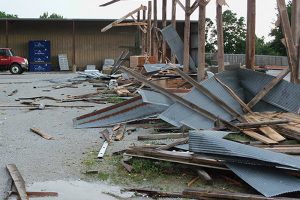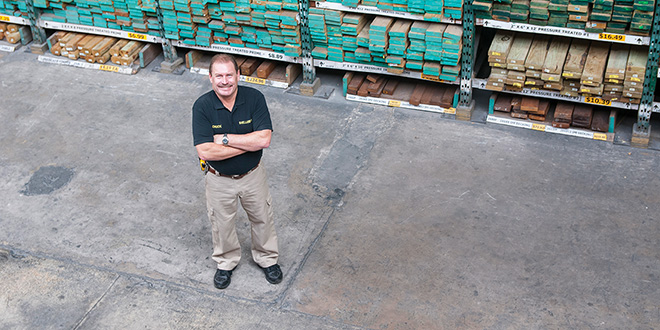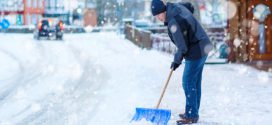
Click the picture to download a PDF of this story.
By Chad Husted, chusted@nrha.org
After the Storm
Shrieking winds, pounding rain, choking smoke—these portents of disaster can haunt communities around the world. Whether it is landslides in the hills of California or the hurricane-ravaged Atlantic Coast, many areas of North America must be on constant alert for natural disasters that can leave communities desperate to rebuild their homes and retain their spirit and morale.
Lumberyards and building materials retailers play a crucial role in this process. While rebuilding a business after a natural disaster hits can be a challenge unto itself, these retailers are some of the first looked to for support by communities hoping to begin the healing process after losing their possessions, property and possibly the lives of citizens.
Adverse situations can alter how a business plans product selection, hiring practices and even buying strategies. Lessons learned during these situations can extend beyond areas prone to natural disasters as well, as businesses even far from the center of a storm can be affected by them through supply chain issues and increased need for certain products.
Shell Lumber & Hardware’s original storefront has been located in Miami since 1928, enduring season after season of South Florida’s hurricanes. The business recently opened a second location in Key Largo, Florida. On the West Coast, Hayward Lumber has seven lumberyards across central California. The Santa Barbara, California, location was recently part of rebuilding efforts after forest fires and landslides closed down roads and demolished nearby homes.
In the Midwest, Joplin, Missouri, is known for tornado damage and the struggle of rebuilding a community after a disaster. Herrman Lumber has been in Joplin since the 1960s and was a member of the business community when a multiple-vortex tornado struck the town in 2011. These three retailers have endured disasters of different kinds and have learned how best to prepare and adapt.
 Putting the ‘B’ in LBM
Putting the ‘B’ in LBM
Building material centers are particularly affected by natural disasters in their communities. With a storm on the radar, these retailers are relied on to have the materials needed to fortify homes and buildings. While hardware stores of all sizes are often called on to help rebuild after a destructive event, lumberyards are often key for consumers due to the increased availability of building materials such as plywood boards and common cut sizes. After the disaster has passed, homeowners and other residents looking to replace or repair damaged buildings come to these retailers to begin the process and access needed products.
John Ruark, branch manager for Shell Lumber’s store in Key Largo, Florida, has been with the company since 1998 after a career with big-box retailers. The Miami headquarters for the business has a 10,000-square-foot hardware store paired with 25,000 square feet of lumberyard that routinely services hundreds of area contractors, builders and homeowners.
Some storms, like Hurricane Katrina, you’ll see a lot of rain, and that’s when products like sandbags, mold removers and tarps are important to have.
Shell Lumber also maintains a separate distribution center a few miles away from its Miami storefront, which allows for more storage potential and is a key part of its ability to maintain products and keep them in stock for potential storms and hurricanes, says Shell Lumber general manager Chuck Strong. Along with the normal supplies for high-end construction, the 2 ½-acre distribution center has evergreen supplies often in high demand and low supply during hurricanes, such as bottled water, construction-strength plastic garbage bags and fencing that is easily set up.
 With years of hurricane preparation under his belt, Ruark says Shell Lumber has been able to stay stocked with needed materials like plywood boards for boarding up windows and openings in a home. Yet each storm is different, he says.
With years of hurricane preparation under his belt, Ruark says Shell Lumber has been able to stay stocked with needed materials like plywood boards for boarding up windows and openings in a home. Yet each storm is different, he says.
“Some storms, like Hurricane Katrina, you’ll see a lot of rain, and that’s when products like sandbags, mold removers and tarps are important to have. Hurricane Irma brought more wind damage and knocked down every fence in Miami-Dade County, so now we’re selling those materials like never before,” Ruark says.
Shell Lumber’s off-site storage and ability to quickly resupply through its distribution center allows it to maintain a strong back-stock in needed materials, but not all retailers can be so prepared year-round. Tornadoes don’t often have the courtesy of signaling their intentions beforehand. When Joplin was hit in 2011, Herrman Lumber store manager Brian Lewis returned to a store with no roof and no power. Demand for tarps, plastic floor mats and generators quickly rose to untenable levels, so Lewis relied on his close relationships with vendors to get materials into the area. Wholesalers can also be helpful in establishing supply lines before a crisis.
Lewis recommends that retailers take particular care to keep themselves loaded with their staples, even when a disaster isn’t looming. Because Herrman Lumber is already heavily invested in roofing, a freak hailstorm in 2017 didn’t deplete its stock even as roofing needs skyrocketed for homeowners.
There are always changes, and storms can alter buying strategies in the short term so you have to be prepared to change course.
“If you’re known for a certain product or service, make sure it’s always on hand and you can’t be caught off guard,” Lewis says. “As far as vendors, that’s also a long-term plan that becomes most important after a disaster. The choices you make months before about who you’re sourcing from will pay off or be a real problem once the storm hits.”
 When rebuilding starts, the supply chain for lumberyards can be particularly taxed in regards to commonly needed lumber and construction supplies. For example, Shell Lumber stocked up on drywall after seeing the destruction from Hurricane Harvey, Ruark says. Lewis has seen sheet rock and roofing supply costs increase after disasters far away from Joplin, and Herrman Lumber has looked to alter its buying strategies accordingly.
When rebuilding starts, the supply chain for lumberyards can be particularly taxed in regards to commonly needed lumber and construction supplies. For example, Shell Lumber stocked up on drywall after seeing the destruction from Hurricane Harvey, Ruark says. Lewis has seen sheet rock and roofing supply costs increase after disasters far away from Joplin, and Herrman Lumber has looked to alter its buying strategies accordingly.
Natural disasters and the subsequent rebuilding phase can alter the industrywide outlook for pricing and buying, Ruark says, but many issues can be mitigated by regional suppliers. The industry as a whole has learned to make adjustments over the years as well.
“Even without building booms after storms, we’re always in the commodity market with our products. There are always changes, and storms can alter buying strategies in the short term so you have to be prepared to change course,” Ruark says. “Long-term plans are easier to keep on track because the industry has gotten so good at logistics.
 A Flood of Customers
A Flood of Customers
How a business reacts in a time of crisis is where it earns trust from its customers or loses their confidence for years to come. Turning around after a disaster and keeping business moving is a point of pride for many retailers. But it’s also just part of doing business in the LBM industry.
Scott Jones, southern market manager for Hayward Lumber, oversees several locations of the company and knows the fine line businesses must walk after a disaster. Pricing for in-demand items will be under intense scrutiny, and any indication of profiteering from customers will draw withering criticism.
“Some items you have to just maintain their price, even if supply is down and prices on your end are rising. Sometimes we donate items for organizations designed to help in relief efforts. There was also a ‘bucket brigade’ of volunteers that was helping homeowners recover after landslides. We sold those buckets at cost,” Jones says.
Assisting customers can go beyond supplying materials, Jones says. Finding nontraditional ways to assist community members can also earn customers’ loyalty, but more importantly, can help a community in ways few others can.
“During the most recent fires, we were contacted by the Santa Barbara Zoo for a possible evacuation of their animals,” Jones says. “We have trucks and manpower that not too many others have in the immediate area, and that’s just one way we could help community members. Luckily the zoo wasn’t forced to evacuate, but there are other areas where we can be of unique help.”
 Strong with Shell Lumber says it isn’t surprising to see customers lining up hours before the business opens in the days leading up to an expected hurricane. Procrastination and the general panic induced by an impending storm can trigger many customers seeking the same products, which is why Shell Lumber has built a plan around how to best serve the most customers.
Strong with Shell Lumber says it isn’t surprising to see customers lining up hours before the business opens in the days leading up to an expected hurricane. Procrastination and the general panic induced by an impending storm can trigger many customers seeking the same products, which is why Shell Lumber has built a plan around how to best serve the most customers.
“We have employees who will go through the line at the register, which can be an eight-hour wait at times, and let them know how much of each item they can purchase,” Strong says. “This customer wants 200 pieces of plywood. Well, the one after him does, too, so we can’t do that. They can have seven. That way the last person in line, even after eight hours, can expect to get his seven boards, too.”
 Rationing products can cause some discomfort for customers, but it ultimately engenders more positive reactions when the storm has passed and customers are no longer panicked, Strong says. Those same customers will remember they were able to get some supplies and that Shell Lumber sells those much-needed supplies at the same price they sell them for when it’s a sunny day in Miami.
Rationing products can cause some discomfort for customers, but it ultimately engenders more positive reactions when the storm has passed and customers are no longer panicked, Strong says. Those same customers will remember they were able to get some supplies and that Shell Lumber sells those much-needed supplies at the same price they sell them for when it’s a sunny day in Miami.
Other ways to assist customers after a disaster include working with them in selecting contractors and other professionals they’ll need to rebuild homes and offices. After the 2011 tornado, Joplin was inundated with contractors and builders from outside the affected area, ostensibly there to help rebuild the community. Lewis is quick to say most were professional and genuinely looking to help while also building their businesses, yet some were taking material on credit and not paying it off, using bad checks and offering exorbitant terms for repair work.
We have so many employees who have been with us for many years, and that’s because we’ve been able to work so closely with them to keep them and their families safe while also getting work done.
“I truly believe that, after a disaster, the level of trust you can build with your neighbor is astounding. People are asking for help, and it brings out the good in people,” Lewis says. “A retailer can be a good neighbor by making sure customers are taken care of. In this industry, we have resources to check out contractors that our customers likely don’t have, so we want to be that resource.”
Taking Care of the Home Team
Assisting customers recently affected by a disaster is a priority for an LBM retailer. Care must be taken to remember another group of area residents who are concerned for their homes and loved ones: employees. While a retailer will likely need all hands available to restore a business to operation, those employees are also working with their minds on their personal struggles.
Shell Lumber has worked with its employees through a number of storms, Strong says, and being just as generous with employees as customers is common practice. If an employee has requested to leave town before a storm hits, it is usually granted by management. The Miami location closed the day before the expected landfall of Hurricane Irma as well, which angered customers seeking last-minute supplies, but allowed employees to protect their own homes after working multiple 18-hour days to cater to the demand at the business.
 “There are limitations you have to accept in the short term, such as staffing shortages if your employees can’t reach the store or if they’ve had to leave town to keep their families safe,” Strong says. “We have so many employees who have been with us for many years, and that’s because we’ve been able to work so closely with them to keep them and their families safe while also getting work done.”
“There are limitations you have to accept in the short term, such as staffing shortages if your employees can’t reach the store or if they’ve had to leave town to keep their families safe,” Strong says. “We have so many employees who have been with us for many years, and that’s because we’ve been able to work so closely with them to keep them and their families safe while also getting work done.”
When mudslides blocked the Pacific Coast Highway south of Santa Barbara in January, Jones knew Hayward Lumber was going to be severely affected by both employee shortages and altered delivery schedules. The Santa Barbara location draws most of its employees from communities on the other side of the closure, so close to a quarter of them would have a difficult time getting to work for what turned into more than a week of closure.
An emergency disaster plan, properly laid out and practiced frequently, is what keeps a business going and its employees secure.
Jones and his managers worked with employees based on their needs as well as the business’s, with employees who were able to be away from home for a few days staying with family close by if available. The idea was also floated, but not implemented, to put employees in hotels if needed. Managers took on responsibilities for workers who couldn’t reach Santa Barbara. Jones credits Hayward Lumber’s training program for allowing this kind of flexibility during a disaster, with heavy emphasis on cross-training employees from onboarding throughout their time with the business.
 “The job market in California is such that it can be very difficult to find qualified individuals in the LBM industry. So when we find one, we train them correctly, from inside sales to support staff and all throughout our salesfloor,” Jones says. “Any inside sales employee or dispatcher, anyone in the organization, starts learning the product in stocking and learning the industry at the sales counter. That’s how you can have depth of knowledge when your staffing situation isn’t ideal.”
“The job market in California is such that it can be very difficult to find qualified individuals in the LBM industry. So when we find one, we train them correctly, from inside sales to support staff and all throughout our salesfloor,” Jones says. “Any inside sales employee or dispatcher, anyone in the organization, starts learning the product in stocking and learning the industry at the sales counter. That’s how you can have depth of knowledge when your staffing situation isn’t ideal.”
Preparing employees for disaster scenarios can keep a business alive after the destruction has passed, but keeping employees alive is more important. From working with employees who are affected during a natural disaster to protecting those on hand during a potential one, retailers are responsible for keeping their workforce safe, Lewis says.
The 2011 tornado hit on a Sunday, a day which Herrman Lumber is commonly closed. However, having a plan in place is necessary in a region of the country that can have storms spring on communities with little to no warning.
“We were fortunate, but you can’t plan on that always being the case. First you plan for everyone’s safety, so if you’re at the store when a storm hits, you know where you’re going and what you’re doing when you get there,” Lewis says. “Once the storm has passed, what are your responsibilities? Everyone has a role, both to keep themselves and the business safe. An emergency disaster plan, properly laid out and practiced frequently, is what keeps a business going and its employees secure.”
 Hardware Retailing The Industry's Source for Insights and Information
Hardware Retailing The Industry's Source for Insights and Information






